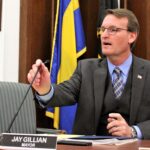New Jersey has announced an effort to develop a new, more aggressive state Energy Master Plan in 2024. The plan development has been placed in the hands of the New Jersey Board of Public Utilities which has already held four virtual hearings. The new plan will replace the 2019 plan that critics attacked for having insufficient analysis of the costs and impacts involved in the transformation of the state’s energy profile which the plan advocates.
As this planning process begins it is useful to consider the broad outlines of the transformation that the state is pushing and the schedule that transformation is on. As we do it, let’s keep in mind the simple, undeniable fact that we sit today almost halfway through 2024.
Gov. Phil Murphy’s agenda, driven almost entirely by executive orders, seeks 100% clean energy use by 2035, just over a decade away.
————–
Murphy himself must sell it to the public, with its costs understood, the sacrifices it will demand known along with the acceptance of the overriding threat.
————–
The agenda calls for a heavy reliance on renewable energy sources, including 11,000 megawatts of offshore wind capacity by 2040. This goal has produced an almost constant acceleration of solicitations for offshore wind farms with the state’s fifth solicitation just moved up by over a full year from what was already an ambitious schedule.
By 2035, that seemingly magical milestone date, all new car and light-duty vehicles sold in the state must be zero-emission vehicles.
By an even more ambitious 2030, the state has a target to install electric space heating and cooling systems in 400,000 homes and 20,000 commercial properties.
So far every target mentioned is the result of executive orders – see orders 315, 316, and 317. So far as well these actions are in advance of the new energy master plan.
But wait, even more is coming. In 2020 Murphy signed Executive Order 100 mandating that the Department of Environmental Protection incorporate projected climate threats into land use rulemaking. A major result of that is the initiative underway to change existing flood hazard, stormwater, coastal zone and freshwater wetlands regulations.
This transformation in how the state creates and uses energy, as well as how it handles its land use regulations, is to happen in a short window and with an equally broad attention to social justice goals. It is a massive metamorphosis with major social, environmental and economic impacts.
Whether this revolution, and that is indeed the word for it, can be accomplished in the time frames postulated is a serious question. The only thing guaranteed is that a failed attempt can result in deep and pervasive havoc across all aspects of state life.
Certainly any chance at success will require strong public support, support for the vision of the threat posed by climate change and support for the specific agenda for combating and adapting to that threat. That support just is not there despite the dust clouds kicked by environmental groups who want to be perceived as representing a broader populace than they actually do.
Polling argues that instead of growing support the Murphy agenda is confronting growing opposition.
A Stockton University poll in September showed waning support for offshore wind projects, falling from nearly 80% approval of offshore wind to barely 50% in just four years.
A Rutgers-Eagleton poll just two months ago showed about half of New Jerseyans are opposed to Murphy’s plan to phase out the sale of new gas-powered vehicles by 2035.
A Monmouth University poll lent further confirmation to the downward shift in support for wind energy. The widespread backing that the wind energy proposal had a decade ago has melted to a bare plurality.
The problem is that pluralities don’t cut it. This is not an election that can be won by a few votes in swing states. The type of transformation that the state is calling for requires broad public support and that cannot be manufactured by executive order.
We are being told by the Murphy Administration that the cost of inaction is too great. The 2019 energy plan delimited two pathways for public policy.
In the first we must engage in ending atmospheric pollution through decarbonization, development of alternative energy sources and similar strategies to reduce greenhouse gasses.
In the second we must adapt to the inevitable impact of climate change that has already occurred and that cannot be reversed. With this policy pathway we get the new land use rules the state is frantically trying to get adopted before term limits drive Murphy from office.
One is almost compelled to ask if the speed with which we are moving is dictated by climate change threats or by the need to establish and cement in place Murphy’s legacy agenda. If we are not confident the agenda will survive his leaving office, we have already condemned it to failure.
Deep and broad public buy-in is essential to any long-term strategic task that must survive the shorter-term changes in office holders. If the democratic process of working through the Senate and Assembly had been followed, this energy plan would more likely receive the needed public support. As it stands, Murphy himself must sell it to the public, with its costs understood, the sacrifices it will demand known along with the acceptance of the overriding threat.
That is the task facing those who feel the transformation outlined in any energy plan is existentially important. The task is not accelerating actions so as to fit them with the window of Murphy’s term in office.
———-
From the Bible: Plans fail for lack of counsel, but with many advisers they succeed. Proverbs 15:22






